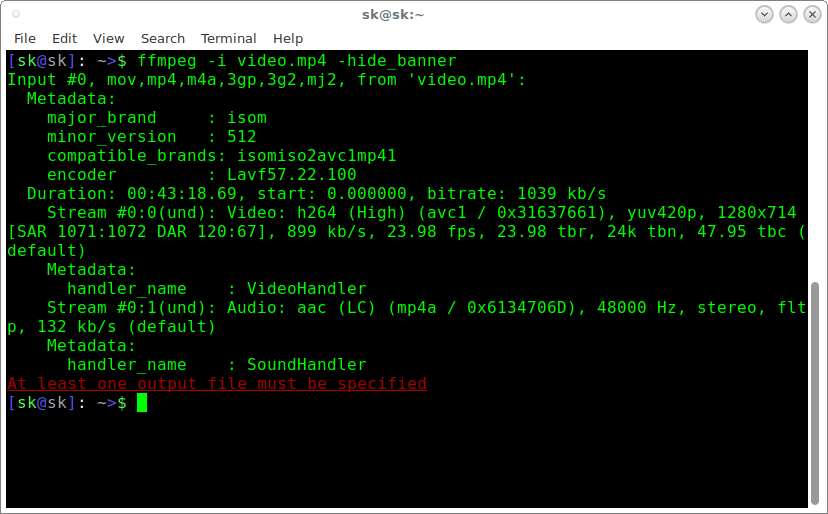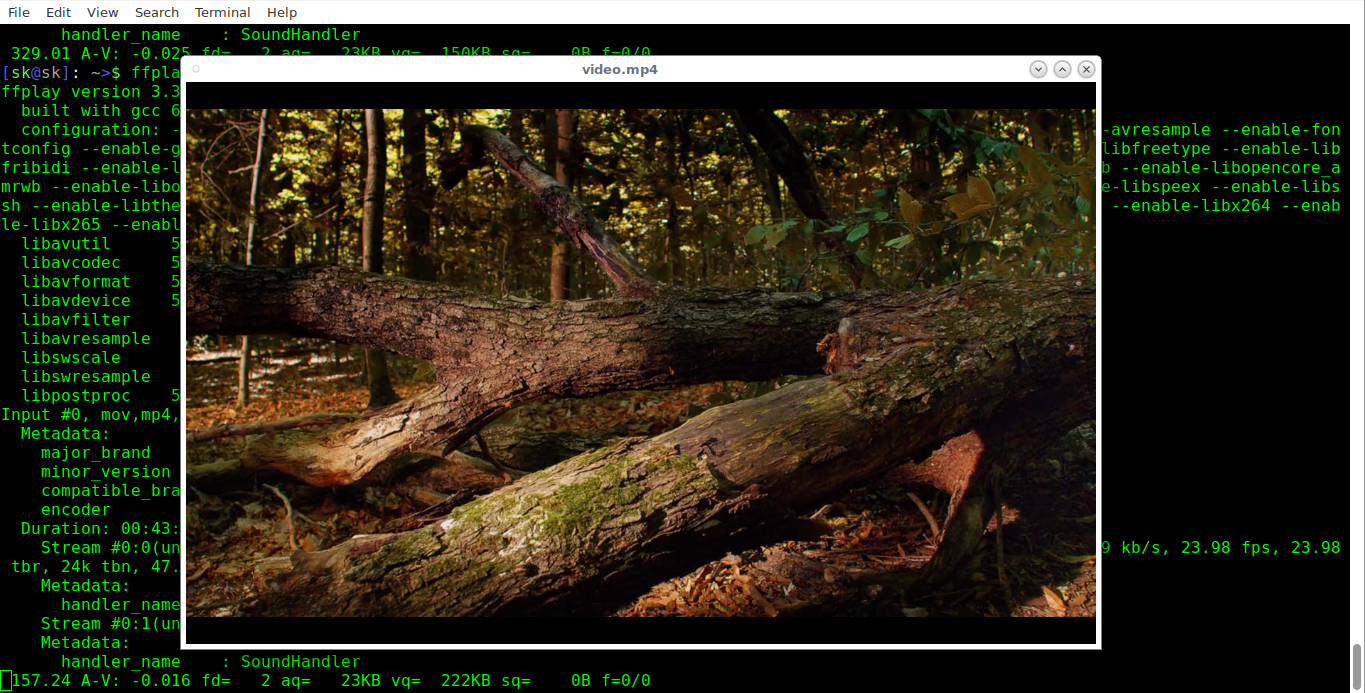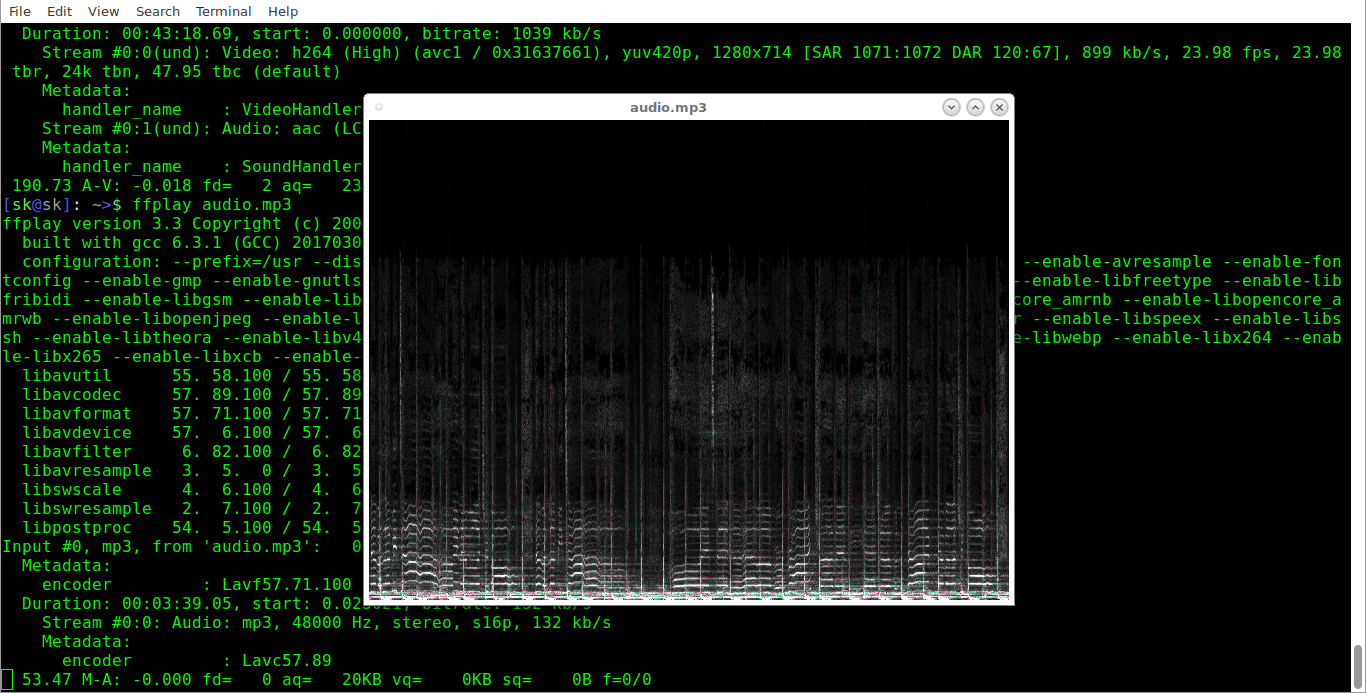Can U Upload Videos To Audiomack
In this guide, I will be explaining how to utilise FFmpeg multimedia framework to do diverse sound, video transcoding and conversion operations with examples. I have compiled most unremarkably and oftentimes used 20+ FFmpeg commands for beginners.
I will keep updating this guide by adding more examples from fourth dimension to time. Delight bookmark this guide and come dorsum in a while to check for the updates. Let us get started, shall we?
Install FFmpeg in Linux
If you lot haven't installed FFmpeg in your Linux organisation however, refer the post-obit guide.
- Install FFmpeg in Linux
FFmpeg commands with examples
The typical syntax of the FFmpeg command is:
ffmpeg [global_options] {[input_file_options] -i input_url} ... {[output_file_options] output_url} ... We are now going to see some important and useful FFmpeg commands.
one. Getting audio/video file information
To brandish the details of a media file, run:
$ ffmpeg -i video.mp4
Sample output:
ffmpeg version n4.one.3 Copyright (c) 2000-2019 the FFmpeg developers built with gcc 8.2.1 (GCC) 20181127 configuration: --prefix=/usr --disable-debug --disable-static --disable-stripping --enable-fontconfig --enable-gmp --enable-gnutls --enable-gpl --enable-ladspa --enable-libaom --enable-libass --enable-libbluray --enable-libdrm --enable-libfreetype --enable-libfribidi --enable-libgsm --enable-libiec61883 --enable-libjack --enable-libmodplug --enable-libmp3lame --enable-libopencore_amrnb --enable-libopencore_amrwb --enable-libopenjpeg --enable-libopus --enable-libpulse --enable-libsoxr --enable-libspeex --enable-libssh --enable-libtheora --enable-libv4l2 --enable-libvidstab --enable-libvorbis --enable-libvpx --enable-libwebp --enable-libx264 --enable-libx265 --enable-libxcb --enable-libxml2 --enable-libxvid --enable-nvdec --enable-nvenc --enable-omx --enable-shared --enable-version3 libavutil 56. 22.100 / 56. 22.100 libavcodec 58. 35.100 / 58. 35.100 libavformat 58. 20.100 / 58. 20.100 libavdevice 58. 5.100 / 58. 5.100 libavfilter 7. xl.101 / 7. 40.101 libswscale 5. 3.100 / 5. iii.100 libswresample 3. 3.100 / 3. 3.100 libpostproc 55. 3.100 / 55. 3.100 Input #0, mov,mp4,m4a,3gp,3g2,mj2, from 'video.mp4': Metadata: major_brand : isom minor_version : 512 compatible_brands: isomiso2avc1mp41 encoder : Lavf58.20.100 Elapsing: 00:00:28.79, start: 0.000000, bitrate: 454 kb/due south Stream #0:0(und): Video: h264 (High) (avc1 / 0x31637661), yuv420p(tv, smpte170m/bt470bg/smpte170m), 1920x1080 [SAR 1:1 DAR 16:9], 318 kb/south, 30 fps, 30 tbr, 15360 tbn, 60 tbc (default) Metadata: handler_name : ISO Media file produced by Google Inc. Created on: 04/08/2019. Stream #0:1(eng): Audio: aac (LC) (mp4a / 0x6134706D), 44100 Hz, stereo, fltp, 128 kb/s (default) Metadata: handler_name : ISO Media file produced by Google Inc. Created on: 04/08/2019. At least ane output file must be specified
As you encounter in the in a higher place output, FFmpeg displays the media file information along with FFmpeg details such as version, configuration details, copyright find, build and library options etc.
If you don't want to see the FFmpeg banner and other details, simply simply the media file information, apply -hide_banner flag like below.
$ ffmpeg -i video.mp4 -hide_banner
Sample output:

Encounter? Now, information technology displays only the media file details.
2. Converting video files to dissimilar formats
Since FFmpeg is a feature-rich and powerful audio and video converter, and so It'south possible to convert media files between dissimilar formats. Say for example, to catechumen mp4 file to avi file, run:
$ ffmpeg -i video.mp4 video.avi
Similarly, yous can convert media files to whatever format of your choice.
For instance, to catechumen YouTube flv format videos to mpeg format, run:
$ ffmpeg -i video.flv video.mpeg
If you want to preserve the quality of your source video file, employ '-qscale 0' parameter:
$ ffmpeg -i input.webm -qscale 0 output.mp4
To check list of supported formats by FFmpeg, run:
$ ffmpeg -formats
3. Converting video files to sound files
To convert a video file to audio file, but specify the output format as .mp3, or .ogg, or any other sound formats.
The higher up command will convert input.mp4 video file to output.mp3 audio file.
$ ffmpeg -i input.mp4 -vn output.mp3
Also, you can employ various audio transcoding options to the output file equally shown below.
$ ffmpeg -i input.mp4 -vn -ar 44100 -ac ii -ab 320 -f mp3 output.mp3
Hither,
-
-vn- Indicates that nosotros have disabled video recording in the output file. -
-ar- Ready the audio frequency of the output file. The common values used are22050,44100,48000Hz. -
-ac- Prepare the number of audio channels. -
-ab- Indicates the audio bitrate. -
-f- Output file format. In our case, it'smp3format.
The above command will display a warning bulletin like beneath.
[libmp3lame @ 0x5589ed539240] Bitrate 320 is extremely low, maybe yous mean 320k The bitrate parameter is set likewise low. It takes bits/s every bit argument, not kbits/due south
This is because we have given 320 bits/2d every bit bitrate which is very low. This volition create a smaller output file. For best quality output, utilize bitrate value every bit 320k instead of just 320.
4. Alter the book of audio files
FFmpeg allows us to change the volume of an audio file using "volume filter" selection.
For example, the post-obit command will decrease volume past half.
$ ffmpeg -i input.mp3 -af 'book=0.five' output.mp3
Similarly, we tin can increase the volume like below:
$ ffmpeg -i input.mp3 -af 'volume=1.5' output.mp3
v. Change resolution of video files
If you want to set a particular resolution to a video file, you lot can employ following command:
$ ffmpeg -i input.mp4 -filter:v calibration=1280:720 -c:a re-create output.mp4
Or,
$ ffmpeg -i input.mp4 -s 1280x720 -c:a copy output.mp4
The above command will gear up the resolution of the given video file to 1280x720.
Similarly, to convert the above file to 640x480 size, run:
$ ffmpeg -i input.mp4 -filter:v calibration=640:480 -c:a re-create output.mp4
Or,
$ ffmpeg -i input.mp4 -s 640x480 -c:a re-create output.mp4
This trick will assist yous to scale your video files to smaller brandish devices such equally tablets and mobiles.
half dozen. Compressing video files
It is always a good idea to reduce the media files' size to lower size to save the deejay space.
The following control volition compress and reduce the output file's size.
$ ffmpeg -i input.mp4 -vf scale=1280:-1 -c:v libx264 -preset veryslow -crf 24 output.mp4
Please note that you will lose the quality if you try to reduce the video file size. You tin can lower that crf value to 23 or lower if 24 is also aggressive.
You could also transcode the audio downwards a fleck and brand information technology stereo to reduce the size past including the following options.
-ac ii -c:a aac -strict -2 -b:a 128k
7. Compressing Sound files
Just like compressing video files, yous tin also compress audio files using -ab flag in order to save some disk space.
Let united states say you lot have an audio file of 320 kbps bitrate. You desire to compress it by irresolute the bitrate to whatsoever lower value like below.
$ ffmpeg -i input.mp3 -ab 128 output.mp3
The list of various available sound bitrates are:
- 96kbps
- 112kbps
- 128kbps
- 160kbps
- 192kbps
- 256kbps
- 320kbps
8. Removing audio stream from a video file
If you don't desire audio from a video file, use -an flag.
$ ffmpeg -i input.mp4 -an output.mp4
Here, 'an' indicates no audio recording. In other words, this option will mute the audio.
The higher up command will disengage all audio related flags.
9. Removing video stream from a media file
Similarly, if you lot don't want video stream, y'all could easily remove it from the media file using 'vn' flag. vn stands for no video recording. In other words, this command converts the given media file into sound file.
The following command will remove the video from the given media file.
$ ffmpeg -i input.mp4 -vn output.mp3
Yous can also mention the output file'south bitrate using '-ab' flag as shown in the following example.
$ ffmpeg -i input.mp4 -vn -ab 320 output.mp3
10. Extracting images from the video
Another useful feature of FFmpeg is we can easily extract images from a video file. This could be very useful, if you want to create a photo album from a video file.
To excerpt images from a video file, utilize the following command:
$ ffmpeg -i input.mp4 -r 1 -f image2 image-%second.png
Here,
-
-r- Set the frame rate. I.e the number of frames to be extracted into images per second. The default value is25. -
-f- Indicates the output format i.e paradigm format in our case. -
prototype-%2d.png- Indicates how we want to name the extracted images. In this case, the names should get-go likeepitome-01.png,prototype-02.png,image-03.pngand then on. If yous use%3d, then the name of images volition start likeimage-001.png,image-002.pngthen on.
11. Cropping videos
FFMpeg allows to crop a given media file in any dimension of our choice.
The syntax to ingather a video file is given below:
ffmpeg -i input.mp4 -filter:5 "crop=westward:h:10:y" output.mp4
Here,
-
input.mp4- source video file. -
-filter:v- Indicates the video filter. -
crop- Indicates crop filter. -
w- Width of the rectangle that we want to crop from the source video. -
h- Superlative of the rectangle. -
x- x coordinate of the rectangle that we want to crop from the source video. -
y- y coordinate of the rectangle.
Let us say y'all want to a video with a width of 640 pixels and a pinnacle of 480 pixels, from the position (200,150), the control would be:
$ ffmpeg -i input.mp4 -filter:five "crop=640:480:200:150" output.mp4
Delight note that cropping videos will bear upon the quality. Practise not do this unless it is necessary.
12. Convert a specific portion of a video
Sometimes, you might desire to convert only a specific portion (duration) of the video file to different format. Say for example, the following control will convert the first 10 seconds of given video.mp4 file to video.avi format.
$ ffmpeg -i input.mp4 -t x output.avi
Here, we specify the the time in seconds. Likewise, it is possible to specify the time in hh.mm.ss format.
13. Set the aspect ratio to video
Yous can gear up the aspect ration to a video file using -attribute flag like below.
$ ffmpeg -i input.mp4 -attribute sixteen:9 output.mp4
The commonly used aspect ratios are:
- 16:nine
- 4:3
- 16:10
- five:4
- 2:21:1
- 2:35:1
- 2:39:ane
14. Adding affiche epitome to media files
You tin add the poster images to your files, and then that the images volition be displayed while playing the sound or video files. This could be useful to host sound files in Video hosting or sharing websites.
$ ffmpeg -loop 1 -i inputimage.jpg -i inputaudio.mp3 -c:v libx264 -c:a aac -strict experimental -b:a 192k -shortest output.mp4
fifteen. Trim a media file using start and terminate times
To trim down a video to smaller prune using start and stop times, nosotros can employ the following control.
$ ffmpeg -i input.mp4 -ss 00:00:50 -codec copy -t 50 output.mp4
Here,
-
--s- Indicates the starting fourth dimension of the video clip. In our example, starting time is the 50th second. -
-t- Indicates the total fourth dimension elapsing.
This is very helpful when you desire to cut a part from an audio or video file using starting and catastrophe time.
Similarly, we can trim down the audio file like beneath.
$ ffmpeg -i audio.mp3 -ss 00:01:54 -to 00:06:53 -c copy output.mp3
16. Split audio/video files into multiple parts
Some websites will let you to upload only a specific size of video. For example, Whatsapp will permit but 15 seconds videos to set as status message for users in Bharat. In such cases, y'all can split the large video files into multiple smaller parts similar below.
$ ffmpeg -i input.mp4 -t 00:00:xxx -c re-create part1.mp4 -ss 00:00:xxx -codec re-create part2.mp4
Here, -t 00:00:30 indicates a part that is created from the get-go of the video to the 30th 2d of video. -ss 00:00:30 shows the starting time postage for the next function of video. It ways that the 2nd role volition start from the 30th second and volition go along up to the stop of the original video file.
17. Joining or merging multiple audio/video parts into one
FFmpeg will too bring together the multiple video parts and create a single video file.
Create bring together.txt file that contains the verbal paths of the files that you want to join. All files should be same format (same codec). The path name of all files should be mentioned one by one similar below.
file /abode/sk/myvideos/part1.mp4 file /home/sk/myvideos/part2.mp4 file /home/sk/myvideos/part3.mp4 file /abode/sk/myvideos/part4.mp4
Now, join all files using command:
$ ffmpeg -f concat -i join.txt -c copy output.mp4
If yous get an error something similar beneath;
[concat @ 0x555fed174cc0] Unsafe file proper name '/path/to/mp4' join.txt: Performance non permitted
Add "-safe 0" :
$ ffmpeg -f concat -safe 0 -i join.txt -c copy output.mp4
The higher up control will join part1.mp4, part2.mp4, part3.mp4, and part4.mp4 files into a single file chosen "output.mp4".
Alternatively, you can use the post-obit i-liner control to join all files in a directory. Become to the directory where you have files and run the post-obit command to join the files named audio1.mp3, audio2,mp3 and audio3.mp3 into output.mp3.
$ ffmpeg -i "concat:audio1.mp3|audio2.mp3|audio3.mp3" -c copy output.mp3
eighteen. Add subtitles to a video file
We can likewise add subtitles to a video file using FFmpeg. Download the right subtitle for your video and add it your video as shown below.
$ fmpeg -i input.mp4 -i subtitle.srt -map 0 -map 1 -c copy -c:5 libx264 -crf 23 -preset veryfast output.mp4
19. Preview or exam video or sound files
Yous might want to preview to verify or exam whether the output file has been properly transcoded or not. To exercise and then, yous can play it from your Terminal with command:
$ ffplay video.mp4

Similarly, you tin examination the audio files as shown below.
$ ffplay audio.mp3

twenty. Increase/decrease video playback speed
FFmpeg allows you to adjust the video playback speed.
To increase the video playback speed, run:
$ ffmpeg -i input.mp4 -vf "setpts=0.five*PTS" output.mp4
The command will double the speed of the video.
To ho-hum down your video, y'all need to utilise a multiplier greater than one . To decrease playback speed, run:
$ ffmpeg -i input.mp4 -vf "setpts=4.0*PTS" output.mp4
21. Increase/subtract Audio playback speed
To increase or decrease speed up or down audio playback, use the "atempo" audio filter. The following command will double the speed of audio.
$ ffmpeg -i input.mp4 -filter:a "atempo=ii.0" -vn output.mp4
You can use whatever value between 0.5 and 2.0 for audio.
22. Create Animated GIF
We use GIF images on almost all social and professional networks for various purposes. Using FFmpeg, we can easily and quickly create animated video files.
The following guide explains how to create an animated GIF file using FFmpeg and ImageMagick in Linux and Unix-similar systems.
- How To Create Animated GIF In Linux
23. Create videos from PDF files
I collected many PDF files, mostly Linux tutorials, over the years and saved in my Tablet PC. Sometimes I experience likewise lazy to read them from the tablet.
So, I decided to create a video from PDF files and sentry it in a big screen devices like a Goggle box or a Computer. If you ever wondered how to make a pic file from a collection of PDF files, the following guide will assistance.
- How To Create A Video From PDF Files In Linux
24. Rotate Videos
If you have video files with different orientation (portrait or landscape), you can rotate them as described in the following guide.
- How To Rotate Videos Using FFMpeg From Commandline
25. Convert Videos To WhatsApp Video Format
WhatsApp doesn't support some videos. Yous can't share them with your contacts or ready them in whatsapp condition. No worries! We can easily catechumen videos WhatsApp supported video format with FFmpeg equally described in the following link.
- Convert Videos To WhatsApp Video Format With FFmpeg
26. Zoom in and zoom out videos
FFmpeg has a lot of useful filters to perform a specific job. One of them is zoompan. Using zoompan filter, we tin can hands zoom in and zoom out every X seconds periodically. Refer the following link for more details:
- How To Zoom In And Zoom Out Videos Using FFmpeg
27. Getting assistance
In this guide, I have covered the most commonly used FFmpeg commands. Information technology has a lot more different options to exercise various advanced functions. To acquire more most it, refer the homo page.
$ man ffmpeg
And, that's all. I hope this guide has given y'all plenty FFmpeg command examples to getting started with FFmpeg.
Source: https://ostechnix.com/20-ffmpeg-commands-beginners/
Posted by: bryantlosigiand.blogspot.com


0 Response to "Can U Upload Videos To Audiomack"
Post a Comment